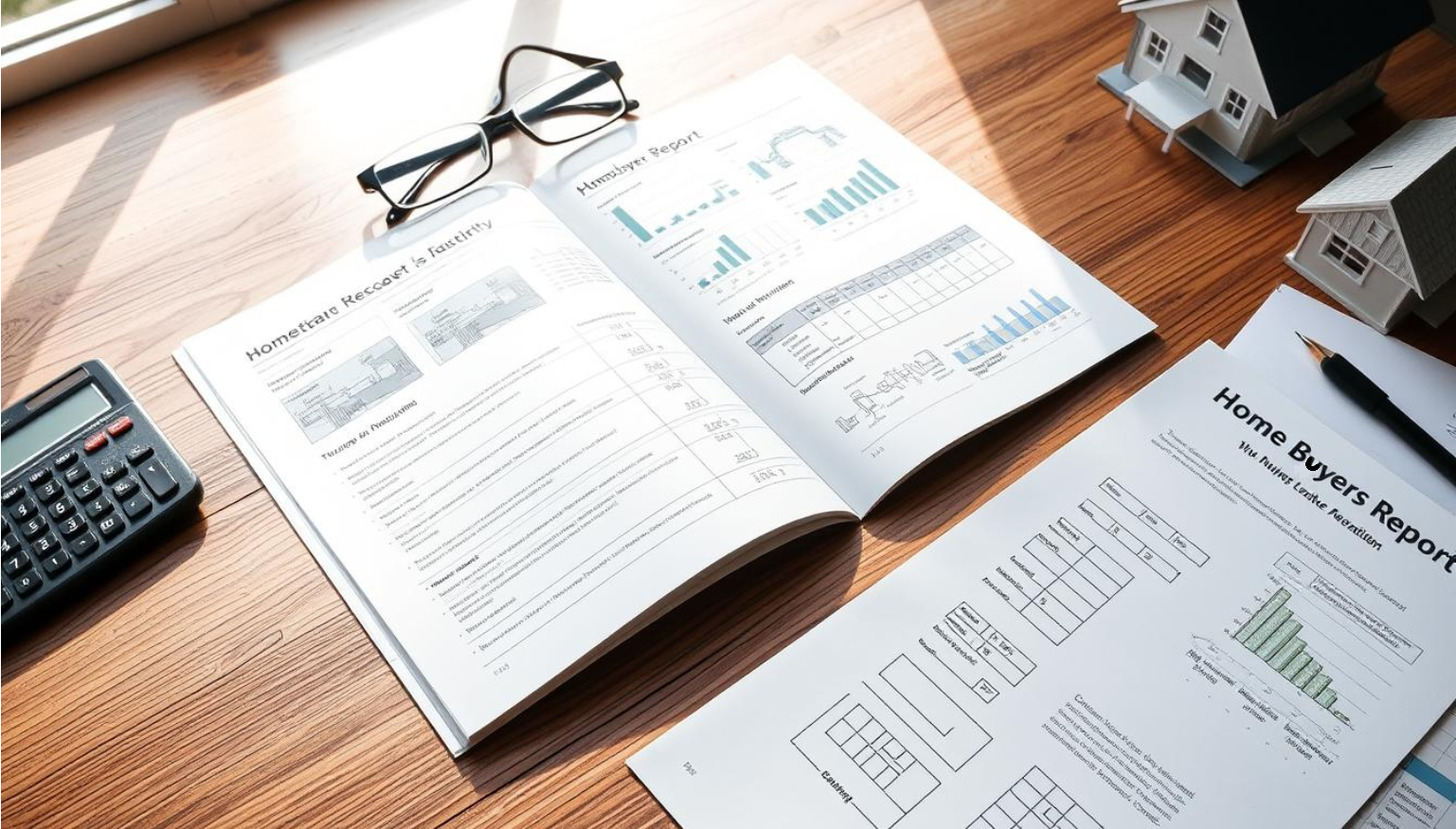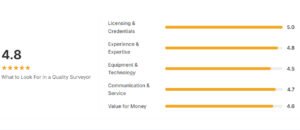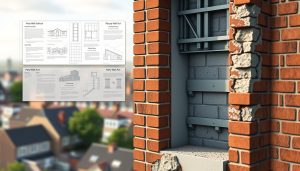In the UK, a property assessment is critical when purchasing a home. There are two primary assessments: the homebuyers report and the full building survey. Each has its purpose and is suited for various property types. These assessments uncover structural flaws or necessary repairs, enabling a thorough understanding of the property’s state. In England, Wales, and Northern Ireland, a survey is mandatory for buyers. Scotland, on the other hand, requires a Scottish Home Report before a property can be listed for sale.
The homebuyers report is a preferred choice for many, as it offers a detailed overview of the property’s condition. It highlights any defects or repairs needed. In contrast, the building survey is more detailed, ideal for larger or older properties. It provides a detailed analysis of the property’s structure and condition. The cost varies, with Level 2 Homebuyers Surveys ranging from £600 to £1,500 and Level 3 Building Surveys from £700 to £2,500 plus VAT.
Selecting the appropriate property assessment is vital to avoid unexpected costs. The Royal Institution of Chartered Surveyors (RICS) regulates surveyors, stressing the importance of choosing a RICS accredited surveyor. Opting for the right assessment ensures a complete understanding of the property’s condition, facilitating an informed purchase decision.
Key Takeaways
- A homebuyers report and a building survey are two types of property assessments available in the UK.
- A property assessment can help identify any structural damage or needed repairs.
- The cost of a homebuyers report or building survey varies, depending on the property’s type and size.
- It is essential to choose a RICS accredited surveyor for your property assessment.
- A building survey is more detailed, suitable for larger or older properties.
- A homebuyers report provides a detailed overview of the property’s condition, including any defects or needed repairs.
Understanding Property Surveys in the UK Property Market
In the UK, purchasing a property necessitates a professional evaluation to guarantee an informed decision. Property surveys are integral to the market, providing buyers with a thorough understanding of the property’s condition and any impending issues. They are essential for identifying structural damage or required repairs, which can be financially burdensome.
The UK market offers various property survey types, including Level 1 Condition Reports, Level 2 Homebuyer Reports, and Level 3 Building Surveys. Each survey type caters to different property conditions and ages. For instance, a Condition Report is suitable for new or modern homes in excellent condition. In contrast, a Homebuyer Report is ideal for properties constructed within the last 50 years. A Building Survey is recommended for older properties, larger homes, or those that have undergone significant renovations.
The Importance of Professional Property Assessment
A professional assessment offers buyers peace of mind and helps avoid unforeseen expenses. The Royal Institution of Chartered Surveyors (RICS) indicates that about 70% of older properties may have structural defects or require substantial repairs. By opting for a property survey, buyers can uncover these issues before making a purchase.
Different Types of Surveys Available
The UK property market offers several survey types:
- Level 1 Condition Report: suitable for new or relatively modern homes in good condition
- Level 2 Homebuyer Report: designed for properties built within the last 50 years
- Level 3 Building Survey: ideal for older properties, more expensive or larger homes, or buildings that have undergone significant renovations
Legal Requirements and Recommendations
While property surveys are not mandatory, they are highly advisable for prospective buyers. In Scotland, sellers must provide a Home Report, which includes a property survey, valuation, council tax band, past issues, alterations, and an Energy Performance Certificate (EPC). It is vital to engage a qualified surveyor, affiliated with the Chartered Institute of Building (CIOB), Royal Institute of Chartered Surveyors (RICS) or the Residential Property Surveyors Association (RPSA), to ensure a detailed and accurate property assessment.
| Survey Type | Cost | Suitable For |
|---|---|---|
| Condition Report | £500-£1,000 | New or relatively modern homes in good condition |
| Homebuyer Report | £600-£1,500 | Properties built within the last 50 years |
| Building Survey | £700-£2,500+ | Older properties, larger or more expensive homes, or buildings that have undergone significant renovations |
What is a Homebuyer's Report?
A homebuyers report offers detailed condition ratings for each property element, pinpointing major issues and suggesting maintenance. It is ideal for homes under 100 years old. The RICS Chartered Surveyors in Wimbledon London suggest a HomeBuyer Report (Level 2) for standard properties.
The cost of a homebuyers report fluctuates based on property size, age, type, and condition. Typically, a Level 2 Homebuyers Survey costs between £300 and £850. It’s advisable to compare quotes from up to five RICS registered Surveyors to secure the best price. For booking a building survey in Wimbledon, London, visit wimbledonsurveyors.com.
A Homebuyer Report involves visual checks of major indoor and accessible outdoor features. It may also include a reinstatement value, the estimated cost to rebuild for insurance purposes. The report covers the property’s interior and exterior, including services and the site. It provides condition ratings for various elements, such as external and internal features, and services.
Here are some key elements of a Homebuyer Report:
- Visual inspections of major indoor and outdoor features
- Condition ratings for various property elements
- Identification of significant issues and defects
- Maintenance advice and recommendations
Compared to a standard valuation, a Homebuyer Report is more costly but less than a Building Survey. It’s important to remember that a Homebuyer Report does not cover inaccessible or non-visible parts of the property. These are typically examined in a Building Survey.
Comprehensive Building Surveys Explained
A comprehensive building survey offers a detailed examination of a property’s state, providing a thorough analysis of its condition. It is highly beneficial for assessing older properties, those constructed from unusual materials, or those that have undergone significant renovations. Unlike a Homebuyer’s Report, a building survey delves deeper, making it essential for buyers seeking a detailed understanding of a property’s condition.
Properties that are older, possess unique features, or have undergone extensive modifications are ideal candidates for a building survey. These surveys uncover hidden issues such as structural damage, dampness, or other defects that might not be evident at first glance. By opting for a building survey, buyers can acquire a detailed insight into the property’s condition, enabling them to make well-informed decisions regarding their purchase.
The duration and process of a building survey vary, typically lasting between 2-4 hours or even an entire day, contingent on the property’s size and complexity. The surveyor meticulously inspects all accessible areas, including the roof, walls, floors, and foundations. The ensuing report offers a detailed assessment of the property’s condition, pinpointing any defects or issues that require attention.
| Survey Type | Recommended For | Duration |
|---|---|---|
| Homebuyer’s Report | Conventional homes in good condition | 1-2 hours |
| Building Survey | Older properties, unique features, or extensively modified properties | 2-4 hours minimum |
Cost Comparison: Homebuyers Report or Building Survey
In the realm of property acquisition, the cost comparison between a homebuyers report and a building survey is of utmost importance. The financial outlay for these evaluations can differ substantially, impacting the decision-making process for prospective homeowners. Typically, a homebuyers report falls within the range of £600 to £1,500, whereas a building survey can escalate to £700 to £2,500+.
The property condition and size significantly influence the survey costs. For instance, a property in pristine condition and of standard dimensions might necessitate a less detailed examination, leading to reduced expenses. On the contrary, a larger or more antiquated property may demand a more thorough assessment, elevating the financial burden. Further, the inability of the surveyor to access certain areas or the presence of complex issues can also drive up the cost of a building survey.
It is imperative to acknowledge that these figures represent estimates and can fluctuate based on the property’s specific attributes and the surveyor’s fees.
To summarise, while both homebuyers reports and building surveys offer distinct advantages and come with varying costs, a cost comparison is instrumental in identifying the most appropriate option for one’s financial constraints and requirements. By taking into account the property’s condition, size, and valuation, prospective buyers can make an informed choice, selecting the survey that offers the most value for their investment.
| Survey Type | Average Cost |
|---|---|
| Homebuyers Report | £600 – £1,500 |
| Building Survey | £700 – £2,500+ |
| Additional Valuation with Building Survey | minimum £250 |
When to Choose Each Survey Type
When selecting between a homebuyer’s report and a building survey, it’s vital to assess the property’s age and construction type. The choice of survey can significantly influence the purchase price and the buyer’s decision-making process. For instance, properties over 50 years old or those with unusual constructions may necessitate a more detailed survey, such as a Level 3 RICS Building Survey.
A property’s age and construction type are critical in determining the survey choice. Older properties or those with unique constructions may require a more detailed survey to identify hidden defects. The Royal Institution of Chartered Surveyors (RICS) advises a Level 3 survey for properties over 50 years old, of unusual design, or in poor condition.
Property Age Considerations
Properties built before 1980 or those in poor condition may necessitate a Full Building Survey. This survey provides detailed information on hidden defects, remedial work scopes, risk assessments, and repair priorities. In contrast, modern properties in reasonable condition may be suitable for a Level 2 survey, which is the most basic and affordable survey.
Construction Type Factors
The construction type of a property can also influence the survey choice. For example, properties with thatched roofs or significant age issues may require a more thorough survey due to hidden defects. A Level 2 survey, such as a homebuyer’s report, may be suitable for conventional, traditionally built properties that are not in disrepair.
Purchase Price Impact
The survey choice can also impact the purchase price of a property. A detailed survey, such as a Level 3 survey, can provide detailed information on the property’s condition, aiding in negotiations. The following table summarizes the typical costs of different survey types:
| Survey Type | Typical Cost |
|---|---|
| Level 1 Survey | £500-£1,000 |
| Level 2 Survey (Homebuyer’s Report) | £600-£1,500 |
| Level 3 Survey (Building Survey) | £700-£2,500 or more |
In conclusion, the survey choice depends on various factors, including the property’s age, construction type, and the buyer’s intentions. By considering these factors and choosing the right survey type, buyers can make informed decisions and avoid pitfalls.
The Survey Process and Timeframes
The survey process commences with an initial contact with a surveyor, followed by a detailed discussion of the property assessment needs. The surveyor will then conduct a site visit, which can vary from 1 hour for a Level 1 Condition Report to 8 hours for a Level 3 Building Survey. This duration is influenced by the timeframes and the complexity of the property. For example, a RICS Home Survey Level 1 (Condition Report) typically requires less than an hour, whereas a RICS Home Buyer Survey (Level 2) may take between 1-2 hours to complete.
Following the survey, a professional surveyor will discuss the findings with the buyer. This discussion aims to clarify the report’s implications. The average time to receive a Homebuyers Survey report is 2-3 working days. In contrast, the average time for a Building Survey report can be up to 5 working days. For further details on the survey process and property assessment services, Enfield property surveyors provide valuable insights.
Key considerations for the survey process and timeframes include:
- Level 1 Condition Report: 1 hour to complete
- Level 2 Homebuyers Survey: 1-2 hours to complete
- Level 3 Building Survey: 2-4 hours to complete
- Average waiting time for Homebuyers Survey report: 2-3 working days
- Average waiting time for a Full Building Survey report: up to 5 working days
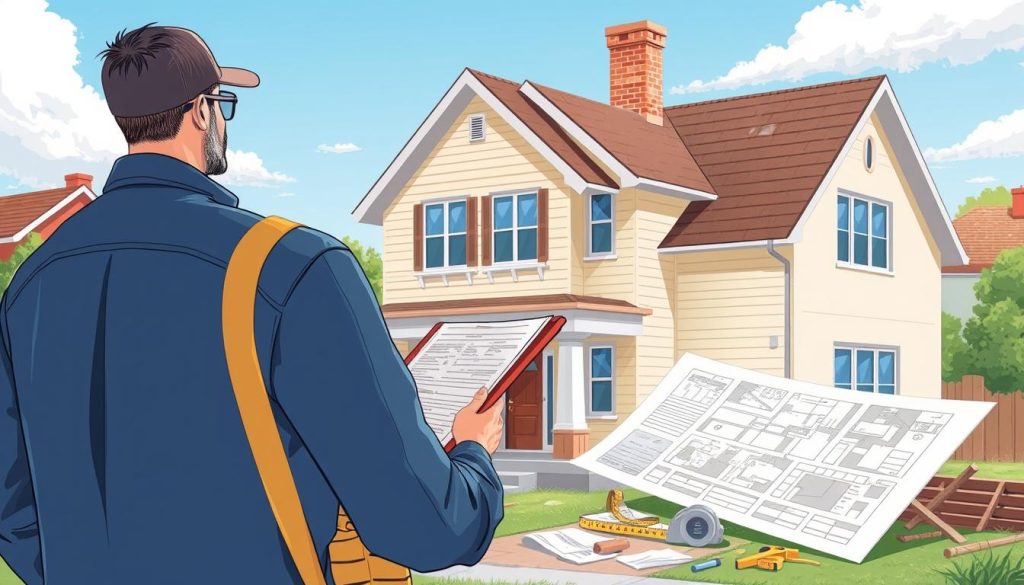
Understanding the survey process and timeframes is critical for a seamless property assessment. By selecting the appropriate surveyor and being aware of the timeframes involved, buyers can make well-informed decisions regarding their property acquisition.
Understanding Survey Results and Reports
Upon receiving your survey results, it is imperative to comprehend the nuances of interpreting the findings. Typically, survey reports employ a traffic light condition rating system. This system categorises properties as green, indicating no immediate need for repairs; amber, signifying defects that require attention but are not urgent; and red, denoting serious defects necessitating urgent repair or replacement.
The report summary encapsulates the surveyor’s findings, conclusions, and recommendations for necessary actions. It is essential to meticulously review these sections to fully grasp the surveyor’s evaluation of the property’s condition. Survey results can be complex, necessitating a thorough understanding of each report aspect.
Common issues highlighted in reports encompass structural damage, dampness, and electrical or plumbing malfunctions. Adhering to the surveyor’s recommendations can prevent future, costly repairs. By comprehending your findings, you can make informed decisions regarding your property acquisition.
- Condition rating system: green, amber, and red
- Findings: summary of the surveyor’s observations
- Conclusions: overall assessment of the property’s condition
- Recommendations: suggested actions to address any issues
By meticulously reviewing your survey results and reports, you can ensure a well-informed decision regarding your property purchase.
| Condition Rating | Description |
|---|---|
| Green (Condition Rating 1) | No immediate repairs needed, normal maintenance may be required |
| Amber (Condition Rating 2) | Defects that require attention but are not urgent |
| Red (Condition Rating 3) | Serious defects needing urgent repair or replacement |
Making Your Final Decision
In the process of selecting between a Homebuyer’s Report and a Building Survey, several critical factors must be weighed. The choice hinges on the buyer’s specific requirements and the property’s condition. Obtaining professional advice is imperative for an informed decision-making process.
The Royal Institution of Chartered Surveyors (RICS) reveals that UK house buyers typically spend £5,750 on repairs after moving in. This statistic underlines the necessity of a detailed survey before purchasing. Both the Home Buyers Report and Building Survey employ a condition rating system, akin to a “traffic light system”, to assess property elements.
Key Factors to Consider
When deliberating, consider the property’s age, condition, construction type, and purchase price. For instance, properties over 50 years old might necessitate a Building Survey’s detailed analysis. In contrast, modern, well-maintained properties might suffice with a Homebuyer’s Report.
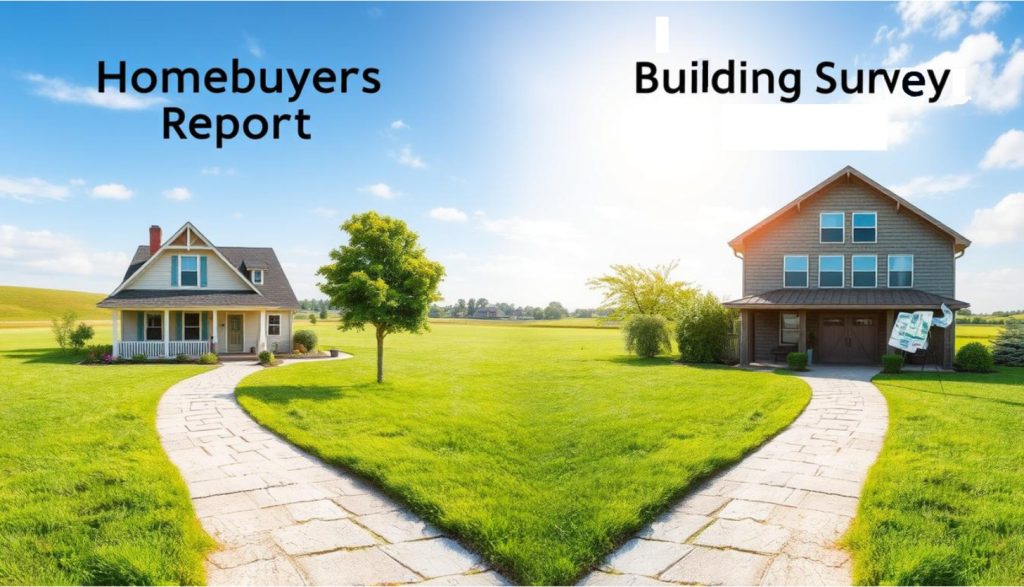
Professional Advice Guidelines
Seeking counsel from a qualified surveyor is critical to making an informed choice. A surveyor can deliver a detailed report on the property’s condition, pointing out any issues or defects. This guidance is invaluable, helping to avoid unforeseen expenses. RICS advocates for surveys for all property buyers, regardless of their confidence in the property’s condition.
By evaluating these factors and consulting with professionals, you can make a decision that aligns with your needs and the property’s condition. Remember, investing in a survey is a prudent move, potentially saving thousands in future repair costs.
Conclusion
In our journey through the realms of homebuyers reports and building surveys, it’s evident that the choice of property assessment is vital for a successful home purchase. The homebuyers report and building survey provide distinct insights, tailored to various property types and buyer requirements.
Whether you’re embarking on your first home purchase or are a seasoned property investor, it’s imperative to weigh the factors we’ve discussed. These include the property’s age, construction, and your budget. This careful consideration will empower you to make an informed choice. Armed with the right knowledge, you can confidently navigate the survey process, safeguarding your investment and ensuring a seamless homebuying experience.
The survey transcends a mere formality; it’s a critical step in comprehending the true state of the property you’re contemplating. By opting for the appropriate survey, you gain the insight necessary for a well-informed decision. This approach helps you steer clear of unforeseen expenses and allows you to revel in the joy of discovering your ideal home.
FAQ
What is the difference between a homebuyer’s report and a building survey?
A homebuyer’s report offers a general assessment of a property’s condition. In contrast, a building survey provides a more detailed analysis. This is essential for older or unique properties.
When is a homebuyer’s report most appropriate?
A homebuyer’s report is ideal for standard, modern properties in good condition. It gives an overview of the property’s state and highlights any major issues.
What does a building survey entail?
A building survey involves a thorough examination of the property. It looks at the structure, materials, systems, and any defects. The survey provides a detailed report on the property’s condition and any necessary repairs or maintenance.
How much do homebuyer’s reports and building surveys typically cost?
The cost of a homebuyer’s report and a building survey varies. It depends on the property’s size, location, and age. Generally, a homebuyer’s report is less expensive than a full building survey.
How long does the survey process take?
The time to complete a property survey varies. It depends on the survey type and the surveyor’s availability. A homebuyer’s report may take a few days, while a building survey can take a week or more.
How do I interpret the results of a property survey?
The survey report details the property’s condition, including any issues or defects. It’s vital to review the report carefully. Seek professional advice if you have concerns or questions about the findings.
How do I decide between a homebuyer’s report and a building survey?
The choice between a homebuyer’s report and a building survey depends on several factors. Consider the property’s age, price, construction type, and your specific concerns. Consulting with a professional surveyor is recommended to determine the most suitable survey for your needs.


